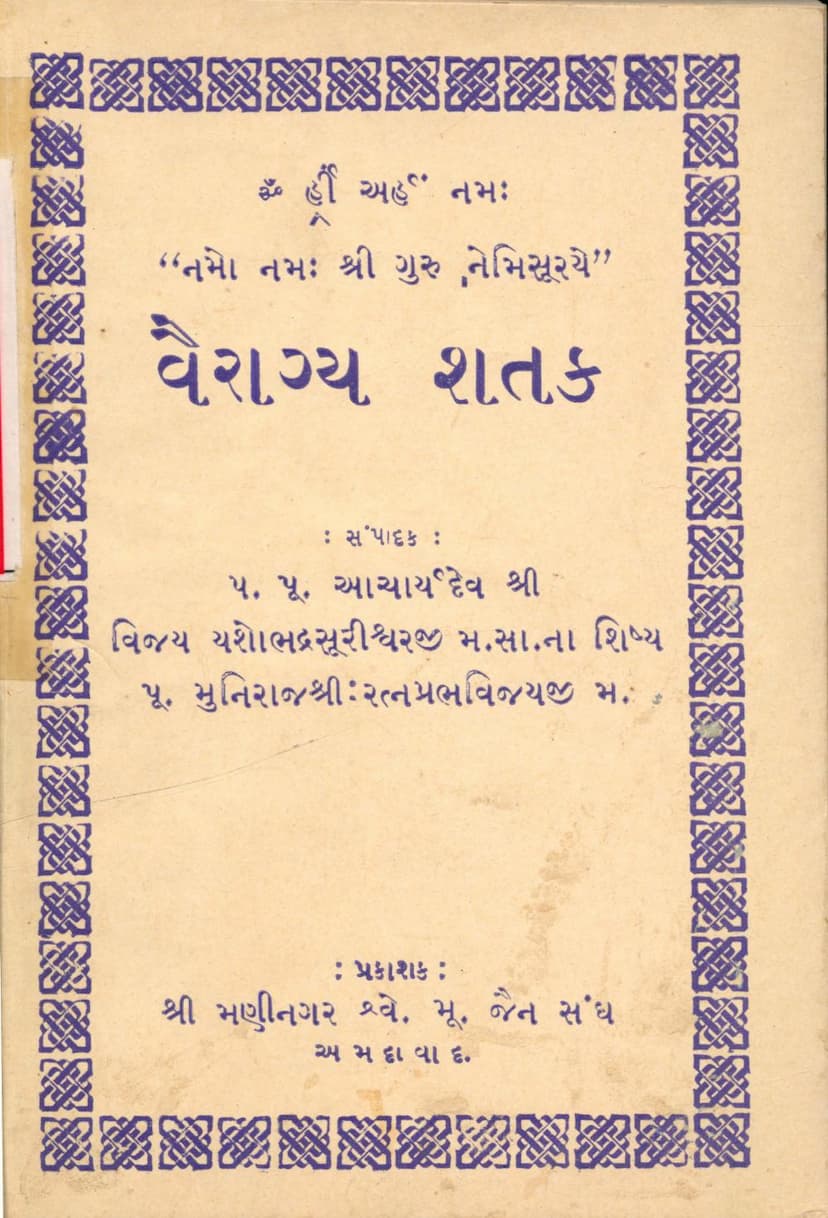Vairagya Shatak
Added to library: September 2, 2025

Summary
The text you provided is a Gujarati translation of the Vairagya Shatak, a Jain scripture authored by Ratnaprabhvijay. The publisher is Shri Maninagar Shwetamber Murtipujak Jain Sangh, located in Ahmedabad.
This book, as indicated by its title "Vairagya Shatak" (meaning "Hundred Verses on Dispassion"), is a collection of verses and discourses aimed at fostering detachment (vairagya) from worldly pleasures and attachments, and encouraging the pursuit of spiritual liberation.
Here's a summary of the key themes and content present in the provided pages:
Core Theme: Detachment and Renunciation
- The Impermanence of the World: The text repeatedly emphasizes the transient nature of worldly possessions, relationships, and the physical body. It highlights that everything in this material world is temporary and will eventually be left behind.
- The Soul's True Nature: It contrasts the impermanent material world with the eternal, unchanging nature of the soul (atma). The ultimate goal is to realize this true self, free from the cycle of birth and death.
- The Illusory Nature of Worldly Happiness: Worldly pleasures are depicted as fleeting and ultimately leading to suffering. The text advises against seeking happiness in these temporary things.
- The Importance of Detachment: True happiness and peace are found in renouncing attachments and cultivating dispassion towards worldly affairs.
- The Path to Liberation: The verses guide the reader towards the path of spiritual discipline, self-control, and devotion to Jain principles as the means to achieve liberation (moksha).
Key Concepts and Narratives:
- The Teachings of the Tirthankaras: The text frequently refers to the teachings of the Tirthankaras, particularly Lord Mahavir Swami, emphasizing their profound wisdom and guidance.
- The Story of Atimukta Kumar (Aimutta Kumar): A significant portion of the text narrates the story of Prince Atimukta, who, even in his youth and surrounded by worldly comforts, developed a strong sense of detachment after hearing the divine words of Lord Mahavir. His parents' initial resistance and eventual acceptance of his spiritual calling are detailed.
- The Story of King Shrenik and the Frog: The narrative of King Shrenik's attachment to his kingdom and the consequences of his actions, contrasted with the wisdom of his ministers and the teachings of Jainism, is presented.
- The Story of King Nami: The story of King Nami's journey from attachment to detachment and ultimately to liberation is highlighted, demonstrating the power of spiritual realization.
- The Nature of the Body: The text describes the body as impure, perishable, and ultimately a source of suffering, advising against excessive attachment to it.
- The Cycle of Birth and Death (Samsara): The continuous cycle of rebirths across different realms (heaven, hell, animal, human) due to karma is explained, stressing the urgency of breaking free from it.
- The Dangers of Worldly Desires: The text warns against the allure of sensual pleasures, wealth, and relationships, as they bind the soul to the cycle of samsara.
- The Power of Knowledge and Conduct: True spiritual progress is achieved through right knowledge (samyak jnan), right faith (samyak darshan), and right conduct (samyak charitra).
- The Importance of Right Effort: While fate or destiny plays a role, the text also emphasizes the importance of continuous effort and vigilance in spiritual practices.
- The Nature of Karma: The verses explain how karma binds the soul and the necessity of purifying oneself from karmic accumulations through righteous actions and detachment.
- The Four Noble Truths (Implied): The emphasis on suffering in the world and the path to its cessation points towards the fundamental Jain teachings on the nature of suffering and its remedy.
Overall Tone and Purpose:
The "Vairagya Shatak" aims to awaken the reader to the realities of existence, inspire them to cultivate dispassion towards the impermanent, and guide them towards the path of spiritual upliftment and liberation. The language is devotional and persuasive, urging the reader to reflect, introspect, and take practical steps towards a spiritual life.
The catalog link provided points to the Jain Quarterly archives, indicating this is a scholarly publication or a translation of a significant Jain text. The book appears to be a collection of sermons or discourses by Muni Ratnaprabhvijayji, elaborating on the original "Vairagya Shatakam" composed by ancient scholars.